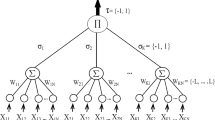Abstract
In continuous-variable quantum key distribution (CV-QKD), weak signal carrying information transmits from Alice to Bob; during this process it is easily influenced by unknown noise which reduces signal-to-noise ratio, and strongly impacts reliability and stability of the communication. Recurrent quantum neural network (RQNN) is an artificial neural network model which can perform stochastic filtering without any prior knowledge of the signal and noise. In this paper, a modified RQNN algorithm with expectation maximization algorithm is proposed to process the signal in CV-QKD, which follows the basic rule of quantum mechanics. After RQNN, noise power decreases about 15 dBm, coherent signal recognition rate of RQNN is 96%, quantum bit error rate (QBER) drops to 4%, which is 6.9% lower than original QBER, and channel capacity is notably enlarged.









Similar content being viewed by others
References
Rogers, S.: Digital signal processing in telecommunications. Control Eng. Pract. 11, 1641 (1997)
Grosshans, F., Assche, G.V., Wenger, J., et al.: Quantum key distribution using gaussian-modulated coherent states. Nature 421, 238–241 (2003)
Jouguet, P., Jacques, S.K., Leverrier, A., et al.: Experimental demonstration of long-distance continuous-variable quantum key distribution. Nat. Photon. 7, 378–381 (2013)
Jouguet, P., Jacques, S.K., Debuisschert, T., et al.: Field test of classical symmetric encryption with continuous variable quantum key distribution. Opt. Express 20, 14030–14041 (2012)
Bennett, C.H., Brassard, G.: Quantum cryptography: public key distribution and coin tossing. Proc. IEEE Int. Conf. Comput. Syst. Signal Process. 175, 175–179 (1984)
Chong, S.K., Hwang, T.: Quantum key agreement protocol based on BB84. Opt. Commun. 6, 1192–1195 (2010)
Elser, D., Bartley, T., Heim, B., et al.: Feasibility of free space quantum key distribution with coherent polarization states. New J. Phys. 11, 045014 (2009)
Lorenz, S., Korolkova, N., Leuchs, G.: Continuous variable quantum key distribution using polarization encoding and post selection. Appl. Phys. B 79, 273–279 (2004)
Shaari, J.S., Bahari, A.A.: Improved two-way six-state protocol for quantum key distribution. Phys. Lett. A 45, 2962–2966 (2012)
Becir, A., El-Orany, F.A.A., Wahiddin, M.R.B.: Continuous-variable quantum key distribution protocols with eight-state discrete modulation. Int. J. Quantum Inf. 1, 181–186 (2012)
Zhong, K., Lei, X., Li, S.Q.: Wiener filter based channel estimation for high-speed communication environments. Wirel. Pers. Commun. 69, 1819–1845 (2013)
Wu, H.H., Jin, F.J., Lai, Y.L., Wang, L.: A stochastic filtering algorithm using SchrÄodinger equation. Acta Automat. Sinica 40, 2370–2376 (2014)
Rupp, M.: Asymptotic equivalent analysis of the LMS algorithm under linearly filtered processes. EURASIP J. Adv. Sig. Pr. 1, 1–16 (2016)
Zhu, Z., Gao, X., et al.: Analysis on the adaptive filter based on LMS algorithm. Optik 11, 4698–4704 (2016)
Rao, K.R., Prasad Rao, P.V.R.D., et al.: Development of RLS algorithm for localization in wireless sensor networks. Procedia Comput. Sci. 65, 58–64 (2015)
Dawes, R.L.: Quantum neurodynamics: neural stochastic filtering with the Schroedinger equation. IJCNN Proc. 1, 133–140 (1992)
Gandhi, V., Prasad, G., Coyle, D., et al.: Quantum neural network-based EEG filtering for a brain–computer interface. IEEE T. Neur. Net. Lear. 25, 278–288 (2014)
Behera, L., Sundaram, B.: Stochastic filtering and speech enhancement using a recurrent quantum neural network. In: International Conference on Intelligent Sensing & Information Processing, Chennai, India, 4–7 January 2004
Behera, L., Kar, I., Elitzur, A.C.: A recurrent quantum neural network model to describe eye tracking of moving targets. Found. Phys. Lett. 18, 357–370 (2005)
Gandhi, V, McGinnity, T.M.: Quantum neural network based surface EMG signal filtering for control of robotic hand. In: International Joint Conference on Neural Networks, Dallas, TX, 4–9 August 2013
Brito, C.S.N., Gerstner, W.: Nonlinear Hebbian learning as a unifying principle in receptive field formation. PLoS Comput. Biol. 12, e1005070 (2016)
Lange, M., Biehl, M., Villmann, T.: Non-Euclidean principal component analysis by Hebbian learning. Neurocomputing 147, 107–119 (2015)
Zivkovic, Z.: Improved adaptive Gaussian mixture model for background subtraction. ICPR 2, 28–31 (2004)
Long, T., Jiao, W., He, G., et al.: Automatic line segment registration using Gaussian mixture model and expectation-maximization algorithm. IEEE J. Select. Top. Appl. Earth Obs. Remote Sens. 7, 1688–1699 (2014)
Nguyen, H.D., Mclachlan, G.J.: Maximum likelihood estimation of Gaussian mixture models without matrix operations. Adv. Data Anal. Classif. 4, 371–394 (2015)
Teukolsky, S.A.: On the stability of the iterated Crank–Nicholson method in numerical relativity. Phys. Rev. D 8, 91–101 (2000)
Dempster, A.P., Laird, N.M., Rubin, D.B.: Maximum likelihood from incomplete data via the EM algorithm. J. R. Stat. Soc. 1, 1–38 (1977)
Lvovsky, A.I.: Continuous-variable optical quantum state tomography. Rev. Mod. Phys. 1, 299–332 (2005)
Lin, D.K., Huang, D., et al.: High performance reconciliation for continuous-variable quantum key distribution with LDPC code. Int. J. Quantum Inf. 13, 1550010 (2015)
Vallone, G., Ambrosio, V.D., Sponselli, A., et al.: Free-space quantum key distribution by rotation-invariant twisted photons. Phys. Rev. Lett. 6, 060503 (2014)
Lingaiah, D.: Kalman filtering: theory and practice using MATLAB. IEEE Circ. Devices Mag. 4, 37–38 (2003)
Rawat, M., Rawat, K.: Adaptive digital predistortion of wireless power amplifiers/transmitters using dynamic real-valued focused time-delay line neural networks. IEEE T. Microw. Theory. 1, 95–100 (2010)
Acknowledgements
This work was supported by National Natural Science Foundation of China (NSFC) (61177072) and Key Research and Development Program of Shandong Province (CN) (2017GGX201010).
Author information
Authors and Affiliations
Corresponding author
Rights and permissions
About this article
Cite this article
Lu, W., Huang, C., Hou, K. et al. Recurrent neural network approach to quantum signal: coherent state restoration for continuous-variable quantum key distribution. Quantum Inf Process 17, 109 (2018). https://doi.org/10.1007/s11128-018-1877-y
Received:
Accepted:
Published:
DOI: https://doi.org/10.1007/s11128-018-1877-y




